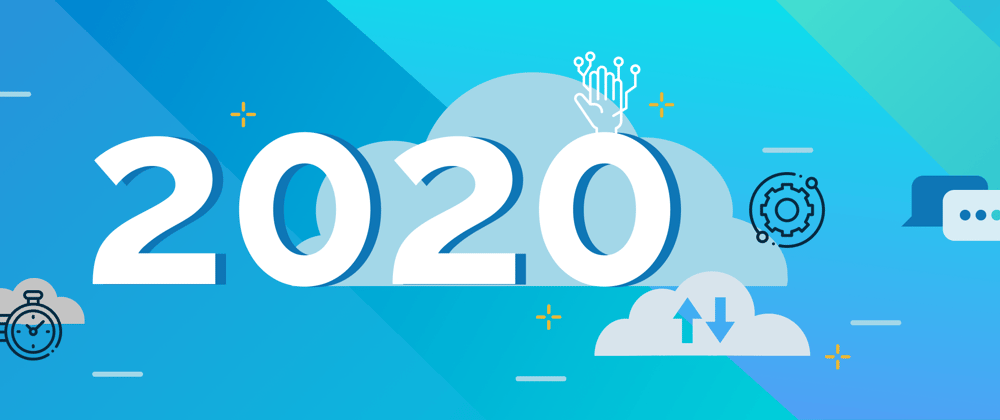When discussing technology trends, 2020 is often deemed to be part of the “post-digital era”. We want to determine whether it is indeed the start of a new historical period or just a bold headline. Let’s look at what technology we should all look out for in the near future.
1. Progressive Web Applications Becoming the Norm
Progressive Web Apps, or simply PWA, have been on the rise for a while now. Here we talk more about PWA. The idea of a website having complex app-like functionality is the next logical stage of evolution of the browser-based technology. Web development, for the longest time, was simplistically perceived as the creation of websites. PWA technology takes this area of software development to the next level. It battles ever-increasing app fatigue and offers a convenient cross-platform solution for mobile and desktop devices at the same time.
2. Artificial Intelligence
It’s hardly a surprise to find artificial intelligence at the forefront of this list. Even though it isn’t a new thing or a hot take, AI is confidently establishing itself in new areas. By all accounts, it is here to stay for years and years to come. In fact, AI software is expected to grow 154% with its value reaching an astounding $14.7 billion by 2025. It’s safe to say that artificial intelligence is not just a trend for 2020 but for all of the 2020s.
As far as the practical application of this technology goes, the range of its uses is truly massive. It is already successfully used in data analysis on every level, and its use in prescriptive analytics and decision making, machine learning, and natural language processing will further solidify AI's place in both our work and personal lives.
3. Increasing Demand for IoT Solutions
There is a misconception among the people who don’t interact with the Internet of Things (IoT) systems that it’s still far in the future. Ironically, for most this line of thinking will soon be a thing of the past. Whether you notice it or not, this technology already impacts the daily lives of millions of people. In the span of five years between 2015 to 2020 the number of devices supporting IoT increased more than 5 times.
From heavy machinery equipment making fields, such as construction being run at never before seen efficiency, to simple kettles you can set to make you tea by the time you get home from work, IoT is everywhere. However, the spread of the usage of IoT demands a wider bandwidth to sustain it. If only there was some kind of technology that can make that possible. Well, there is one such thing...
4. The Spread of 5G Availability
20 Gb/s sounds spectacular to anyone with even the vaguest understanding of internet speed. So, it’s no surprise that widespread 5G availability is so highly anticipated. With the public release being planned in 2020, the hype surrounding this technology has never been greater. Low latency, great bandwidth and the speed of this wireless connection will completely transform the landscape of the internet and tech.
Access to such a high-quality connection removes many boundaries. Augmented reality constantly updated in real-time, buffering-free streaming of huge amounts of data and content, high precision movement tracking, and smart city technology will all be possible thanks to 5G.
5. Lag Elimination via Edge Computing
Edge computing is a revolutionary approach to cloud computing. Just like 5G, the main benefit is the reduced latency. It is achieved by utilizing the edges of the cloud network to be closer to the target. This makes the response time near-instant and enables efficient processing and analysis of large amounts of data whilst also saving bandwidth. With an increasing number of platforms using the network such as IoT and wearable devices, it will be more necessary in the coming decade.
6. Changes to Outsourcing Practices
As outsourcing businesses develop and grow, they find their niches. Their skills grow with experience too. This has resulted in a number of companies focusing and perfecting specific tasks, for example, software development using .NET for IT businesses.
New areas of outsourcing will also emerge. They will include more complex processes that may focus more on business strategy rather than individual operations. Idea generation and innovation are among the new outsourcing fields you can expect to hear more from in 2020. Many companies will elect to establish cooperation with several companies, each working on a separate branch of the client’s workflow.
7. Distributed Cloud Services
As far as trends go, this is an obvious one. Distributed cloud services are already successful and widely used today. Their inclusion in this list is meant to signify the further development within this technology and even wider adoption.
Distributed cloud computing is the type of cloud computing that assembles the platform from a set of machines spread across different locations linked by the same hub. There are two subtypes of this practice: public-resource computing and volunteer cloud computing. Both of them rely on the lending of unused computing power to others.
8. Human Augmentation
While the transhumanist future is still quite a way away, the first steps have already been made. For example, subdermal implants acting like transport passes or contactless credit cards. This technology has the potential to completely overhaul the healthcare industry, but that is hardly a 2020 trend. It needs to be as safe as possible before it can have a large impact.
In this coming year, the human augmentation technology that will find the widest userbase is wearables. Areas such as fitness, military, and mining, have already made a headstart with other fields now following suit. Soon, the software development market will not be limited by only screens.
The hardware application of this type of tech goes beyond enhancing the physical attributes of a person but can enhance the mental aspects as well. The direct communication between a brain and a computer through neuroprosthetic brain-machine interfaces (BMIs) will only develop further in the 2020s, spearheaded by Elon Musk’s Neuralink.
9. Self-Perpetuation of DARQ
What is DARQ? It stands for distributed ledger technology (DLT), artificial intelligence (AI), extended reality (XR), and quantum computing. All four are impactful in their own right. However, what makes them special is the tight connection between them. Development in one aspect of DARQ will drive the other three forward, which, in turn, will only perpetuate further growth. This huge area of potential will silence the doubters and prove that not a single one of the four technologies is a fad.
While blockchain and AI are described in other sections of this article, let’s talk a bit about the other two elements of DARQ. Extended reality is used to enhance the environment of an individual and inject something informative or entertaining into it. This includes both virtual and augmented reality. Quantum computing introduces the concept of ‘superpositions’ instead of just ones and zeros. This will vastly increase the speed of any operation including machine learning and complex decision-making, and even perfectly simulating scientific experiments, among many other groundbreaking feats.
10. Momentary Markets and, Yes, Even More Personalization
At this point, it seems that personalized on-demand experiences have been a trend for at least several decades. We exaggerate, of course, but their popularity indeed continues to grow year after year due to their success. As new algorithms are perfected there are even more ways to cater to your business to each individual customer.
Momentary markets allow you to base your business around moments in the lives of your customers. With the rise of more advanced AI technology, it will enable companies to make the right offers to the right people at the right time. On-demand experiences will employ complex back-end technology and real-time analytics to meet the needs of people across many areas of business.
11. Increasing Democratization of Technology
The field of technology has certainly always been one of the most democratic. New ideas and expertise often take priority over the traditional hierarchy. This trend will continue for the foreseeable future. It will make technology more accessible to more people. This participation introduces different perspectives that can aid in finding new approaches to innovation. With rapidly developing globalization, it further blurs the boundaries across many different fields. Among them are finance, information and, of course, technology.
The cultural impact of these changes has garnered some backlash from supporters of the status quo. For example, with a lowered entry bar some highly-trained specialists may become displaced, or their work may become less valued. As new tech becomes easier to understand and use, many businesses already find it hard to keep up. However, this trend shows no signs of stopping, and will only grow in the future.
12. Decentralization and Different Views on Data Security
Continuing in a similar vein, data security has inspired many arguments. Who should control the data, where should it be located, and how to guarantee its safety? It has been a truly polarising topic, however, the aforementioned democratization of tech has drawn a trajectory for future development.
Blockchain was something that many have written off as a fad that came and went. However, it’s not that simple. It looks like this technology is here to stay. As it becomes more widely adopted in 2020, you’ll particularly notice some changes in data security.
Depending on your personal views you may look on the topic differently. Some believe that the safest place to store data is on a centralized cloud server from a time-proven and reliable provider. Others think that sensitive information should only be stored locally to minimize the risks of leakage. The third option that is currently garnering the most attention is blockchain technology. It allows for data to be reliably encrypted and stored across multiple machines. This ensures that even if several machines are hacked or become unavailable, your data remains safe.
The untraditional approach and lack of a single authority are the reason many people are skeptical despite all the evidence for transparency and security. We’ll see where 2020 takes us, but this promises to have a large impact on the technological landscape as a whole.
13. Hyperautomation
Automation, particularly that of business processes, is something that has been successfully gaining traction for quite some time. Therefore, it’s not really a surprise that it is included on our list. In fact, our company specializes in this technology. Being immersed in this field we can assure you that automation is still in its infancy. Complete elimination of human intervention on a large scale, sometimes called hyperautomation, is the end goal for many businesses.
Hyperautomation can be achieved through further development of the business process and robotic process automation. As businesses successfully implement these solutions, they often seek to continue in a similar vein. Introducing artificial intelligence, for example, can increase the number of potential new operations that can be transformed from tedious work to background processes.
So, What to Expect in 2020?
Trends aren’t always a clear look into the future. Some can peter out, while something completely unexpected can change the entire landscape for years to come. With technology trends, 2020 promises to be an exciting start of a new decade. Rapid growth and innovation are definitely on the horizon for roaring twenties.









Top comments (0)